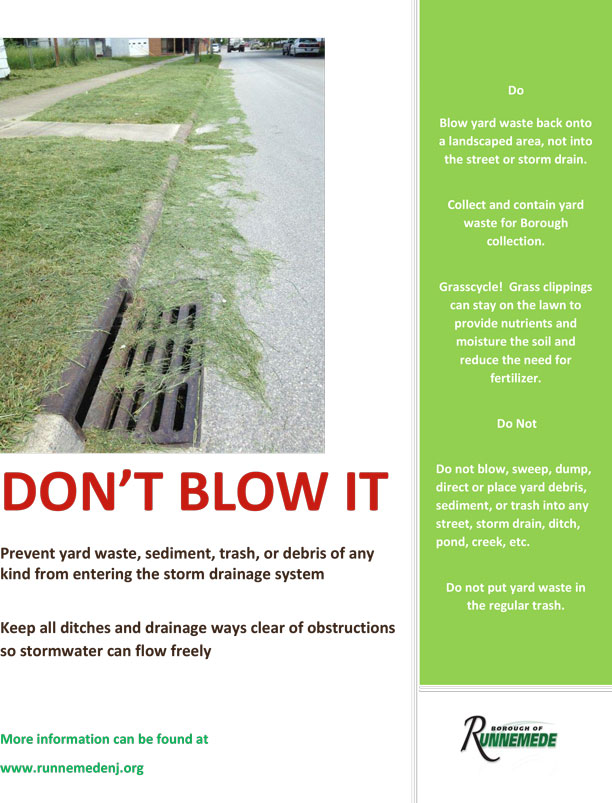What is stormwater?
Human activity is largely responsible for stormwater pollution. Everything that we put on the ground or into the storm drain can end up in our water. Each of us has a responsibility to make sure these contaminants stay out of our water. Whether we have clean water is up to you.
The official definition of stormwater under the New Jersey Pollutant Discharge Elimination System(NJPDES) regulations at N.J.A.C. 7:14A is as follows:
‘Stormwater’ means water resulting from precipitation (including rain and snow) that runs off the land’s surface, is transmitted to the subsurface, or is captured by separate storm sewers or other sewage or drainage facilities, or conveyed by snow removal equipment.
Stormwater Program Coordinator (SPC) Contact Information
If you have any questions about our stormwater program or would like additional information, please contact:
Stormwater Links

Stormwater Pollution Prevention Plan (SPPP)
The SPPP was last updated 1n January 2019 and describes how we implement the stormwater program in order to meet the requirements of our NJPDES Municipal Separate Storm Sewer System (MS4) permit.
Municipal Stormwater Management Plan (MSWMP)
MS4 Outfall Pipe Map
MS4 Infrastructure Map

Watershed Improvement Plan (WIP)
The purpose of the WIP is to identify opportunities to improve water quality, reduce MS4 contribution of pollutants to waterbodies with impairments and Total Maximum Daily Load(TMDLs), and to address stormwater flooding to protect human health and safety, and the environment.

Stormwater Resources
Click on the links below to learn more about stormwater and get access to educational resources.
WHAT IS THE STORM DRAINAGE SYSTEM?
- It’s a network of structures, channels and underground pipes that carry stormwater (rain water) to ponds, lakes, streams and rivers. The network consists of both public and private systems.
- It’s an integral part of the stormwater management system in the borough that is designed to control the quantity, quality, timing and distribution of storm runoff. All stormwater in the borough eventually flows to Timber Creek and then to the Delaware River.
- It’s not part of the wastewater (sanitary sewer) system, which carries water and waste from drains (sinks, bathtubs, showers, etc.) and toilets to a treatment plant to be treated and filtered. Stormwater does not flow to a treatment plant.
WHO MAINTAINS THE DRAINAGE SYSTEM?
The borough maintains the public storm drainage system contained within dedicated storm drainage easements. The New Jersey Department of Transportation maintains the storm systems on Route 168 and Route 41. Camden County maintains the storm system on Clements Bridge Road, Evesham Road and Shubert Ave. There are also numerous private systems that are the responsibility of private property owners, including driveway culverts and storm retention basins.
WHO MAINTAINS THE EASEMENT?
The borough is responsible for maintaining the public drainage system and structures within the storm drainage easement to allow for proper function of the system.
Property owners are responsible for:
- routine grounds maintenance such as grass mowing and trash/debris removal – owners should ensure that systems and structures are kept free of yard waste (grass clippings, tree trimmings, leaves) or other obstructions that may block the flow of water;
- trees, shrubs and other growth within easements;
- driveways and their associated culverts or bridges;
If you have a public drainage system and structures on your property please verify that you have an easement with the Borough. It should be shown on your survey.
WHERE DO I CALL ABOUT…
STORM DRAINAGE MAINTENANCE:
- For maintenance of borough storm drains, assistance in determining who maintains a storm drain, and questions about storm drainage easements, please contact Public Works at 1-856-931-0646.
- Driveway culverts (pipes under driveways that connect the storm drain system on either side) are not part of the public system; they are the property owner’s responsibility.
- Private drainage systems (e.g., driveway culverts/bridges, downspouts, etc.) and ground water are the property owner’s responsibility. Drainage directed from gutters, downspouts or other private systems to neighboring properties is a civil matter between the property owners.
FLOODING:
- For life threatening emergencies, dial 911.
- To report storm flooding during regular business hours, call the Public Works Department at 1-856-931-0646
- For after-hours storm flooding emergencies that are not life threatening, call the 24-hour Camden County Dispatch, and state that you are reporting a storm sewer emergency. 1-856-783-1333
- For sanitary sewer flooding, call the 24-hour pager at 1-856-939-3354
WHAT CAN I DO TO HELP?
- Keep storm drains free of litter and debris. Do not rake or dump grass clippings or leaves into the storm drainage system.
- Keep the area easily accessible in case repairs or maintenance are necessary.
- Do not place sheds or other permanent structures in the easement or on top of drainage structures.
- Apply pesticides and fertilizers several days before rain is forecast; if applied right before a rain, most of it will just wash off and end up in a storm drain.
- Never dump pet waste, used motor oil, paint, chemicals or other substances into a storm drain.
- Report dumping or spilling of hazardous materials into a drainage system to the Fire and Rescue Department: 911;
- Swimming pools should never be drained into storm drains, water shall be pumped into sanitary sewer system by clean put access.
https://www.nj.gov/dep/dwq/pdf/tipcard_carwashfinal.pdf
https://www.nj.gov/dep/dwq/pdf/tipcard_motoroilfinal.pdf
https://www.nj.gov/dep/dwq/pdf/tipcard_fertilizerfinal.pdf
https://www.nj.gov/dep/dwq/pdf/tipcard_petwastefinal.pdf
Runnemede Stormwater Outfall Map




